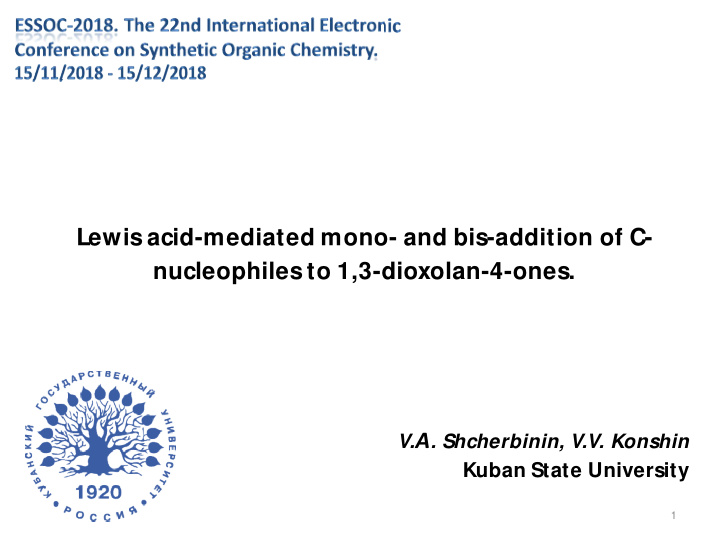



Lewis acid-mediated mono- and bis-addition of C- nucleophiles to 1,3-dioxolan-4-ones. V. А . Shcherbinin, V.V. Konshin Kuban State University 1
OMe O M. Watson, JACS (2011) 17142 A. Baba , Chem. Com. (2013) 11620 Br TMSOTf OAc Fe(OTs) 3 BF 3* OEt 2 O OMe O H. Huang, ChemCat. (2015) 250 O + M. Watson, OL (2015) 3857 BF 3* OEt 2 BF 3* OEt 2 OAc R R TMSOTf or imido- O diphosphorimidate OAc O O A. Romero, JACS (2000) 168 OAc n M. Beaver, Angew. (2016) 1816 S. Murata, TL (1982) 2601 S. Lee, JACS (2017) 2156 2
3
Nucleophilic addition to an oxocarbenium cation generated from 1,3-dioxolan-4-ones 4
Reaction of 1,3-dioxolan-4-ones with silicon containing nucleophiles Nucleophile Product Yield, % Nucleophile Product Yield, % 55 (61:39) 1 84 (62:38) 5 2 76 (76:24) 63 (64:36) 6 3 62 (61:39) - 7 Ph-C ≡ C-SiMe 3 - 4 82 (57:43) Ph-C ≡ C-H 8 5
Reaction of 1,3-dioxolan-4-ones with 1-alkynes Nucleophile Product Yield, % Nucleophile Product Yield, % 1 75 (60:40) 5 50 (75:25) 2 73 (80:20) 6 53 (75:25) 3 67 (75:25) 7 45 (82:18) 45 (80:20) 33 (83:17) 4 8 6
Mechanism of formation of diastereomeric pair 7
Reaction of 1,3-dioxolan-4-ones with aromatic compounds R Nucleophile Product Yield, % R Nucleophile Product Yield, % Ph 54 Ph 76 Ph 28 p-NO 2 Ph 15 - Ph trace Ph 8
Competitive addition of nucleophiles to 1,3-dioxolan-4-one 9
Comparison of the nucleophilicity of the reagents involved in competitive addition 10 Prof. H. Mayr, http:/ / www.cup.lmu.de/oc/ mayr/ DBintro.html
Proposed mechanistic scheme for the transformations 11
Conclusion T etrahedron Letters , 2018, 3005-3309 This work was financially supported by the Russian Science Foundation (project No. 17-73-10251) 12
13
Recommend
More recommend